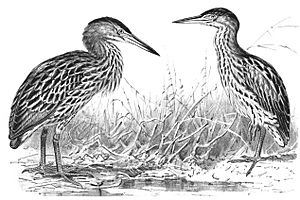New Zealand bittern facts for kids
Quick facts for kids New Zealand bittern |
|
|---|---|
 |
|
| New Zealand bittern (adult and juvenile males) | |
| Conservation status | |
| Scientific classification | |
| Genus: |
Ixobrychus
|
| Species: |
novaezelandiae
|
| Synonyms | |
|
|
The New Zealand bittern (Ixobrychus novaezelandiae) was a mysterious bird. It was a type of heron that lived only in New Zealand. Sadly, this bird is now extinct, meaning it no longer exists. The last time anyone saw a living New Zealand bittern was in the 1890s.
People also called it the New Zealand little bittern or spotted heron. In the Māori language, it was known as kaoriki.
Contents
About the New Zealand Bittern's Family Tree
Scientists study how living things are related. This is called taxonomy. The New Zealand bittern was first described in 1871. A scientist named Alexander Callender Purdie gave it the name Ardeola novaezelandiae.
Some scientists thought it might be a type of little bittern. Others believed it was the same as the black-backed bittern. In 1980, New Zealand scientist Peter L. Horn found old bones of a bittern. He named these bones Dupetor flavicollis. Later, in 1991, Philip Millener confirmed these bones were from the New Zealand bittern.
What the New Zealand Bittern Looked Like
The New Zealand bittern was a small bird. It was about 38 cm (14.75 inches) long. This made it a bit bigger than the common little bittern.
Not many examples of this bird exist today. Because of this, it is hard to know exactly what they looked like. They had a large light brown patch on their upper wings. Their upper body was black with light brown streaks. Their underside had dark brown streaks and a reddish-brown color.
Where the New Zealand Bittern Lived
In recent times, this bird was mostly found on the South Island of New Zealand. Many sightings were in the Westland area. Scientists have found very old bones of the bird on the North Island too. However, some reports of living birds there might have been other types of bitterns.
The first scientific example of the bird was supposedly found in Tauranga on the North Island in 1836. But this example cannot be found today. The main example, called the holotype, is in the Museum of New Zealand. It was found near Lake Wakatipu in Otago. The New Zealand bittern liked to live near the edges of salty lakes and small rivers that had trees.
New Zealand Bittern Behaviour
People who saw the New Zealand bittern described its habits. A man named Mr. Docherty knew the bird well in Westland. He said they lived near salty lagoons by the sea. They always stayed close to the trees.
He often saw them standing on the bank of the lagoon. They would bend their heads forward, watching the water carefully. Other times, they stood very straight up. He believed this was their natural standing position.
Mr. Docherty also mentioned catching one bird about two miles into the forest. It was by a creek that led to a lagoon. He thought they ate small fish or the roots of reeds. He noticed reeds turned up where he caught one, with their roots missing. These birds were very shy and usually found alone. They would stand in one spot for many hours.
What the Bittern Ate
When kept in captivity, the New Zealand bittern was seen eating mudfish and worms. They ate these when the food was placed in water.
The Bittern's Voice
Two different calls of the New Zealand bittern were noted by Walter Buller. One was a "peculiar snapping cry." This sound was used as an alarm call. The other call was described as "not unlike that of a kingfisher," but it was not as loud.
See also
 In Spanish: Avetorillo de Nueva Zelanda para niños
In Spanish: Avetorillo de Nueva Zelanda para niños


